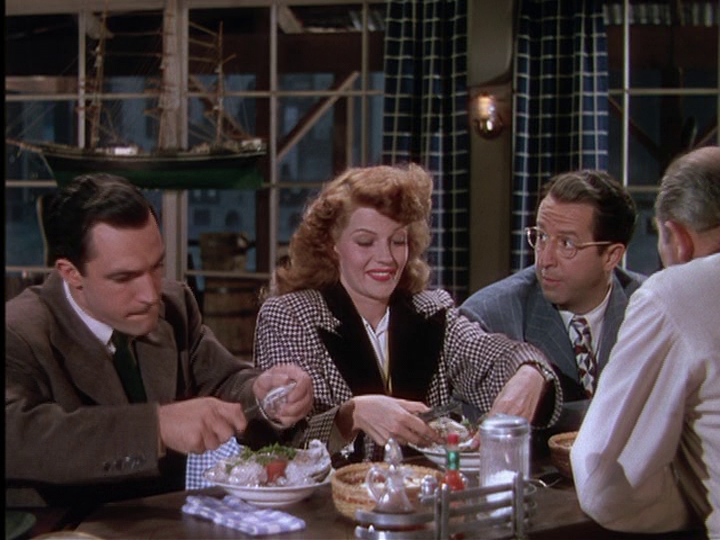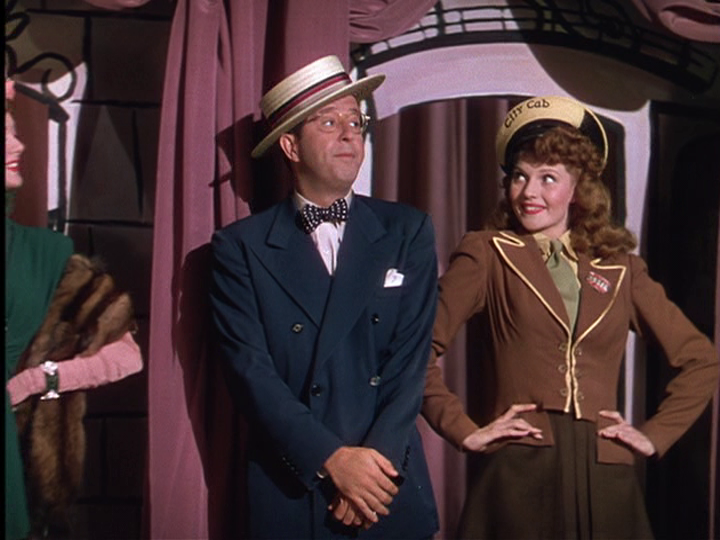Cover Girl, 1944, Columbia Pictures. Starring Rita Hayworth, Gene Kelly. Co-starring Phil Silvers. Directed by Charles Vidor. Technicolor, 107 minutes.
Rusty Parker (Rita Hayworth), a showgirl at a Brooklyn dive nightclub, wants more for her life. She hears about a contest to be a cover girl for a prestigious magazine from Maurine Martin (Leslie Brooks), one of the other young women in her act, and decides to try out. However, when Maurine, who’s also angling for this top prize, fails to win over magazine executive Cornelia Jackson (Eve Arden) she proves she’s not that much of a friend and gives Rusty some bad advice for charming Cornelia.
Maurine’s interview wasn’t entirely for naught, as the magazine’s publisher, John Coudair (Otto Kruger), sees her picture and decides to check out her act. While watching Maurine, he sees Rusty, and is struck by her resemblance to a showgirl he once fell in love with, Maribelle Hicks (Rita Hayworth, in a dual role). As it turns out, Maribelle was Rusty’s grandmother. Soon, Rusty has won the coveted prize as a cover girl.
As thrilled as she is, this isn’t such good news for her boyfriend, Danny McGuire (Gene Kelly), who owns the nightclub she works in. While he adamantly refuses to stand in her way, he desperately doesn’t want to lose her. Soon, however, she’s appearing on Broadway, and Danny, it seems, has indeed lost the woman he loves. But this is a Hollywood musical, and the story doesn’t end there.

Gene Kelly, Rita Hayworth, Phil Silvers
Cover Girl was nominated for five Academy Awards and won one, for Best Music, Scoring of a Musical Picture. It was also nominated for Best Art Direction, Best Cinematography, Best Original Song for “Long Ago (and Far Away),” and Best Sound, Recording. The Best Original Song award that year went to “Swinging on a Star” from Going My Way.
Columbia studio head Harry Cohn originally wanted Dennis Morgan in the role Kelly would play, but gave in to producer Howard Schwartz’ suggestion of Kelly. On loan from MGM, Kelly had yet to make a name for himself, but his work on Cover Girl set him up well. Columbia allowed him to choreograph the musical numbers, something MGM had not permitted, and he brought along his friend Stanley Donen to help him do just that. Cover Girl proved to be a substantial showcase of Kelly’s (and Donen’s) skills, and MGM took notice. Later, when Columbia wanted to use Kelly again for Pal Joey, MGM refused to loan him out.

Phil Silvers, Rita Hayworth
This was Hayworth’s third musical, the first two being You’ll Never Get Rich and You Were Never Lovelier, in which she shared top billing with Fred Astaire. She was the first of only six women to dance onscreen with both Astaire and Kelly.
It was during the filming of Cover Girl that Hayworth married the man she would later call “the love of her life,” Orson Welles. Despite her love for him, the marriage was troubled almost right from the beginning, and the two divorced in 1947.
Cover Girl is a charming musical starring two great talents (and co-starring several others, including Phil Silvers and Eve Arden). While originally intended as a showcase for Rita Hayworth, today it is better remembered as the break-out film for Gene Kelly. It was one of the top-grossing movies of the year, and remains a film well worth the watch.

Phil Silvers–Sgt Bilko! Remember that show? I had no idea he did musicals. I would love to see this movie. My dad had a crush on Rita Hayworth. And Susan Hayward. I think he had a thing for redheads! 😀
LikeLiked by 1 person
Phil Silvers is fun in this movie, does a great job with the musical numbers. As for redheads, none more glamorous than Rita Hayworth. And boy, could she dance!
LikeLiked by 1 person
Rita Hayworth was a beautiful dancer and mesmerising in Gilda. Gene Kelly was also a fabulous dancer – I love him ‘Singing in the rain’ and that dance number with Jerry of Tom and Jerry hehe. Orson Welles sounds like he was a troubled artist.
LikeLiked by 1 person
I agree Orson Welles sounds like he was troubled. And I love both Rita Hayworth’s and Gene Kelly’s dancing. Gene Kelly in the Tom and Jerry number is so much fun. Both he and Fred Astaire were so innovative in their dancing!
LikeLiked by 1 person
I love Fred Astaire too.
LikeLiked by 1 person
Rita Hayworth in Technicolor! She’s eye-candy! And it is also nice to see her in a musical since Rita was an accomplished dancer (I think Fred Astaire said that Rita was her favorite dance partner — eat your heart out Ginger Rogers! 😉 ).
LikeLiked by 1 person
She was a lot of fun in this picture and I agree, quite a dancer. I’ve heard Fred Astaire called her his favorite as well, and I’m not surprised, although he had a number of outstanding dance partners! ☺
LikeLiked by 1 person
https://www.bbc.co.uk/news/entertainment-arts-12717233
Belinda, have you heard? “Dame Olivia de Havilland, who has died at 104 in Paris, was one of the last survivors of Hollywood’s Golden Age.”
LikeLiked by 1 person
Yes, I heard…what a talent she was! Thank you for letting me know!
LikeLiked by 1 person
You’re welcome 🙂
LikeLiked by 1 person
P.S. I always had special affection for Dame Olivia since we attended the same high school–a few years apart, of course.
LikeLiked by 1 person
Fancy that 🙂 xo
LikeLiked by 1 person
Hollywood isn’t magical anymore is it.
LikeLiked by 1 person
No, kind of the opposite. I suppose in some ways it never was, but it sure seemed that way to audiences.
LikeLiked by 1 person
The working conditions for the actors, however big was bad – beholden to the film companies. Hollywood was new, unattainable for ordinary people and the actors looked so glamorous.
LikeLiked by 1 person
Stanley Donen had nothing to do with the choreography of Cover Girl (except counting the beats for the cameraman) and doing some work as a dance-in (rehearsals) for Gene Kelly’s breakthrough Alter Ego dance. Donen was never a choreographer and you will never see a stand alone credit for him as such. In 1944, he was strictly Gene Kelly’s assistant.
LikeLiked by 1 person